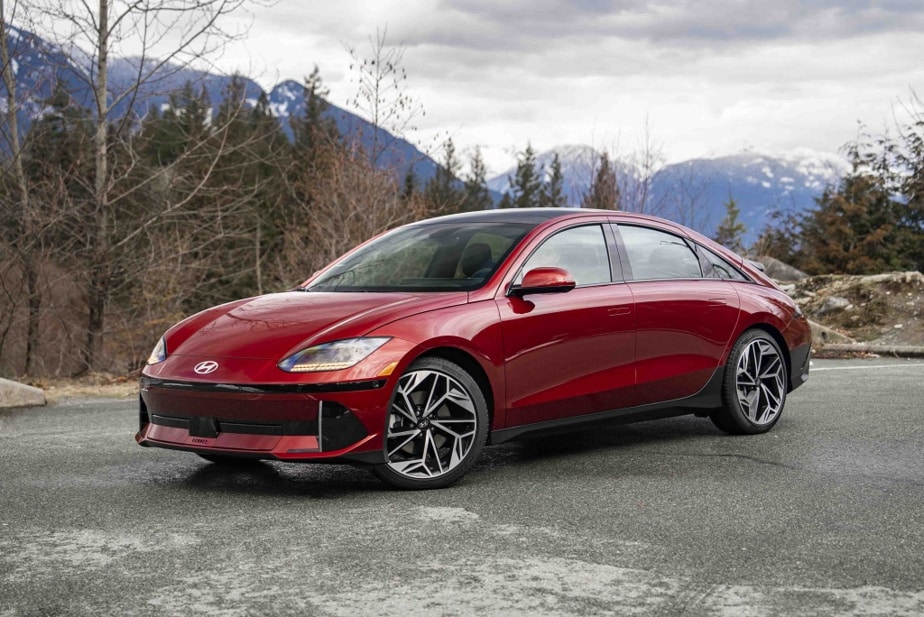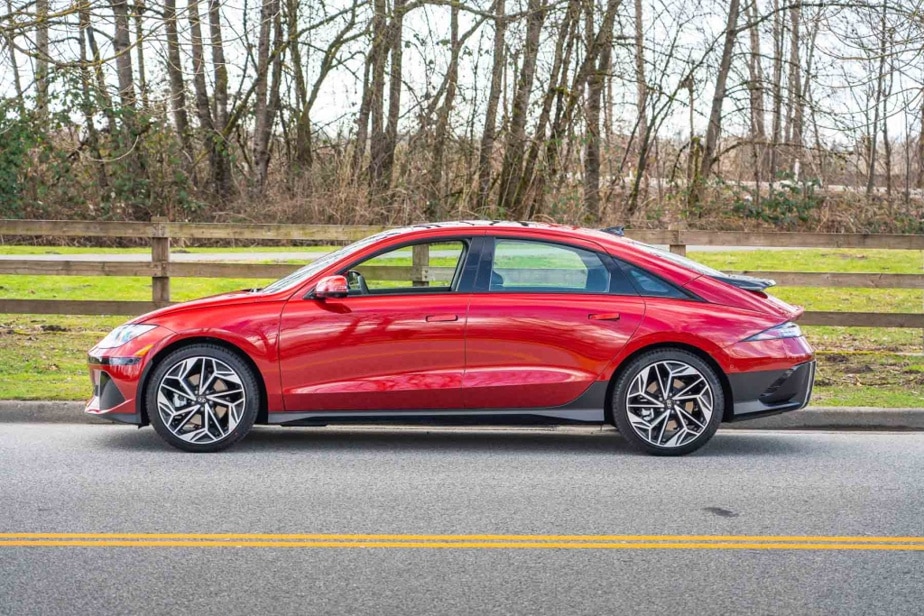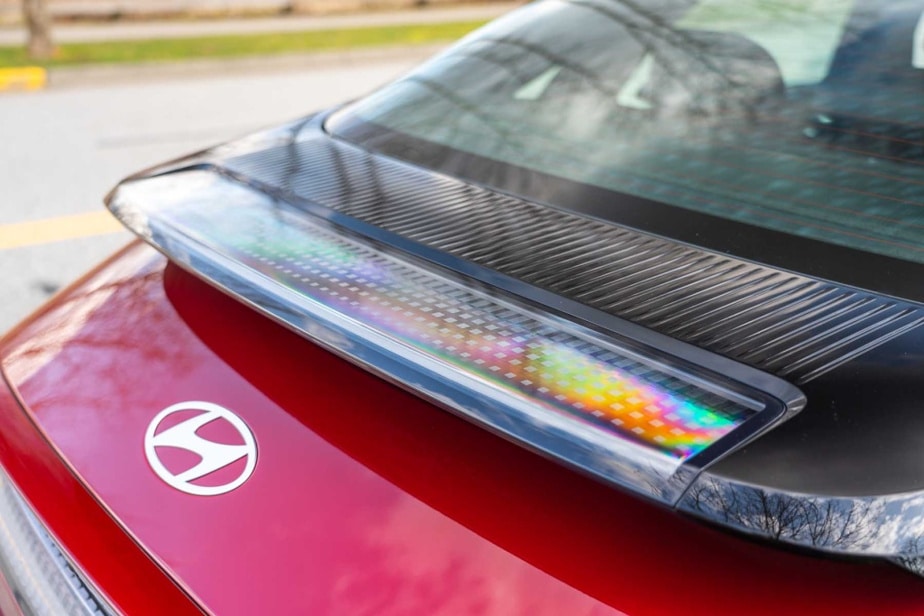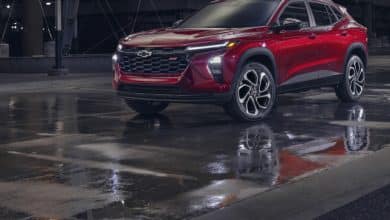Test bench | Hyundai Ioniq 6: a story to tell

(Vancouver) To avoid disappearing in the rush of electric utilities, the Ioniq 6 tells a different story.
Contents
A breath of fresh air
We could have judged her ugly, clumsy. Error: we find in it a kind of non-conformist grace. In this era when all vehicles are alike, the Ioniq 6 brings this dose of originality and even this touch of marginality which attracts attention and threatens the hegemony of the Tesla Model 3.
The bitter observation that “today’s cars all look alike” is obviously not new. However, it must be admitted that the proliferation of models and, above all, the hegemony of SUVs accentuate this impression. No one will dare to make such comments when discovering the Ioniq 6. Although research seems to have predetermined its entire design, this sedan still allowed its designers to demonstrate a healthy fantasy.
Bold architectural imbalance
The versatility of the Ioniq 6 is expressed above all through its lines which evoke the assembly, rather than the synthesis, of a sedan and a coupé. The front part, plunging, as well as the rear, picked up, celebrate the boldness of the South Korean house. The singularity of this model (the anomaly, some will claim) comes from the wheelbase which lengthens the central section disproportionately. This audacious architectural imbalance does not overshadow the maneuverability or the “road feel” of this sedan. This is done at your fingertips. And in silence.
-
PHOTO PROVIDED BY HYUNDAI
The versatility of the Ioniq 6 is expressed above all through its lines which evoke the assembly, rather than the synthesis, of a sedan and a coupé.
-
PHOTO PROVIDED BY HYUNDAI
The volume of the trunk invites you to focus on the essentials when packing your bags.
-
PHOTO PROVIDED BY HYUNDAI
The very offset profile of this sedan breaks the face as soon as you open the doors. We expected more audacity in terms of presentation than a copy-paste of the Ioniq 5’s cabin.
-
PHOTO PROVIDED BY HYUNDAI
The singularity of this model (the anomaly, some will claim) comes from the wheelbase which lengthens the central section disproportionately.
-
PHOTO PROVIDED BY HYUNDAI
The rather slender profile of this sedan has a negative impact on rear headroom. Larger builds risk polishing their scalp against the roof.
-
PHOTO PROVIDED BY HYUNDAI
The Ioniq 6 console
-
PHOTO PROVIDED BY HYUNDAI
The Ioniq 6 deflector
-
PHOTO PROVIDED BY HYUNDAI
The Ioniq 6 selector
-
PHOTO PROVIDED BY HYUNDAI
Ioniq 6 controls
1/9
But the Ioniq 6 can also pitch up. It only asks to release the solid accelerations and accelerations of which its dual motorization (all-wheel drive version) is capable, which smooths the thrust without restraining it up to 185 km/h, its maximum speed. To whip the car, nothing could be simpler. Just select Sport mode, which reduces throttle travel, stiffens the steering and permanently ensures the services of the four-wheel drive train (therefore, of the two motors), and the Ioniq 6 goes for it.
Although it takes over the architecture of the Ioniq 5, the driving sensations of the 6 differ. With a few pounds less and a lower center of gravity, the Ioniq 6 negotiates with more speed the turns that throw themselves in front of its wheels. Admittedly, the steering does not offer a better feeling, but the vehicle’s attitude seems even more stable, which contributes to giving more confidence to the steering wheel. The suspension achieves, for its part, a very good compromise between comfort and handling. As for the braking, easy to modulate and sufficiently powerful, it is combined with a selector which regulates the rate of energy recovery. This allows the car to be driven virtually without using the brake pedal under normal conditions.
Apart from the silence of operation and the fluidity of its movements, it is the energy efficiency of this Ioniq 6 that holds the most attention. In its four-wheel drive configuration, this sedan cut like a drop of water boasts a range of more than 500 km.
A feat that several so-called traditionalist and generalist brands struggle to accomplish, even with a higher density battery. A feat that also highlights the importance of tires in obtaining such performance. Although the weight of the vehicle plays a role here, it has, in this case, a negligible effect compared to the size of the tires.
Pyrotechnic show
The very offset profile of this sedan breaks the face as soon as you open the doors. In short, we expected more audacity in terms of presentation than a copy-paste of the interior of the Ioniq 5. Well, almost. That of the Ioniq 6 allows you to modify the atmosphere using a device combining 4096 color combinations. A real pyrotechnic show. These light signatures are an effective and inexpensive way to display the sacrosanct “technological content” of the Ioniq 6 on the cheap. to be rapidly obsolete.
Even if we welcome the place given to physical controls on board – less distracting than those integrated into the tree structure of the central screen –, there are still some anachronisms. Like these mirrors which are remotely controlled from a panel to the left of the steering wheel.
Furthermore, the rather slender profile of this sedan has a negative impact on rear headroom. The designers of the Ioniq 6 may have redesigned the bench seat to give it a more pronounced angle and a lower seat, but tall people risk having their scalp shine against the headliner. Added to this is a more acrobatic entry and exit. On the other hand, the clearance, both for the legs, the hips and the shoulders, makes a strong impression. More, in any case, than the volume of the trunk, which invites you to focus on the essentials when packing your bags.
And as misfortune never comes alone, this sedan does not recommend that any trailer be attached to it, unlike the Ioniq 5, which some will consider more welcoming. More functional too. For these two reasons, many consumers will prefer the 5. But buyers of the 6 don’t care, what they want is an energy-efficient sedan. And above all, a car capable of competing with the Polestar 2 and Tesla Model 3.
ioniq 6
Price
From $54,999 to $63,999
Eligible for government rebates
Yes
Presumed autonomy
- RWD (1 motor)/18″ tires: 581 km
- AWD (2 motors)/18″ tires: 509 km
- AWD (2 motors)/20″ tires: 435 km
WE love
- Reassuring autonomy
- Return of physical orders
- Attention-grabbing style
We love less
- Trunk volume
- Marked influence of tires (range)
- Towing capacity
Our Verdict
Will the electric fairy re-enchant the sedan?
Technical sheet

PHOTO PROVIDED BY HYUNDAI
ioniq 6
Engine(s)
- 1 electric motor (drive)
- Power: 225 hp; maximum torque: 258 lb-ft
- 2 electric motors (integral)
- Combined power: 320 hp; maximum torque: 446 lb-ft
- Battery: 77.4 kWh
Performance
- Weight: from 1915 kg to 2094 kg
- 0-100 km/h: 7.4 sec (rear-wheel drive), 5.1 sec (all-wheel drive)
- Towing capacity: not recommended
Gearbox
- Standard: automatic
- Optional: none
- Drive modes: rear-wheel drive or all-wheel drive
Tires
Consumption
- 17.6 kWh/100 km (best performance obtained during the test)
Refill
- Level 2 (10% to 100%): 7.10 hours
- Fast 50 kW (from 10% to 80%): 73 minutes
- Fast 350 kW (from 10% to 80%): 18 minutes
Dimensions
- Wheelbase: 2950mm
- Length: 4855mm
- Height: 1495mm
- Width: 1880 mm (exterior mirrors excluded)
The origins

PHOTO PROVIDED BY HYUNDAI
Prophecy Concept
We can see an air of resemblance to the Porsche Panamera or the defunct Infiniti J30. For the record, it should be remembered that the Ioniq 6 was initially presented under the name of Prophecy. This was to make its first public appearance at the Geneva Motor Show in March 2020. The health crisis decided otherwise. In its concept form, the Prophecy featured antagonistic doors and two joysticks as a steering wheel.
5, 6, 7…

PHOTO PROVIDED BY HYUNDAI
ioniq 7
A year from now, the Ioniq family will welcome a new member: the 7. The latter, presented in a conceptual form, gives a foretaste of the mobility of tomorrow, where our vehicles will look like our homes. The storage has been multiplied and almost becomes the cupboards of a house on wheels. Armchairs that move, a U-shaped loveseat that allows you to contemplate the stars through a glass ceiling. Unlike the Seven, however, the final version will not offer passengers to live in such a friendly space where you can do everything without looking at the road. The 7 will therefore not be equipped with a fully autonomous driving device. At least not for now.
The Press will soon publish the test of the following vehicles: Alfa Romeo Tonale, Ford Mustang, Porsche Cayenne and Toyota GR Corolla. If you own one of these vehicles or are waiting for delivery, we would love to hear from you.





















